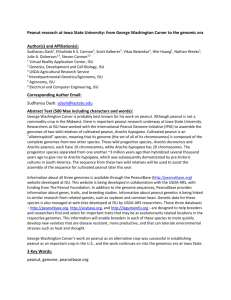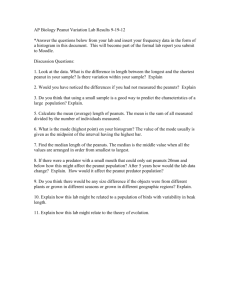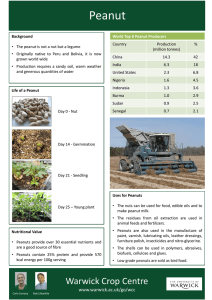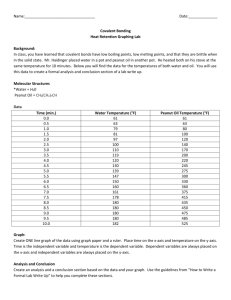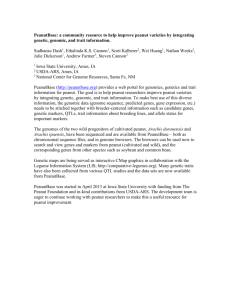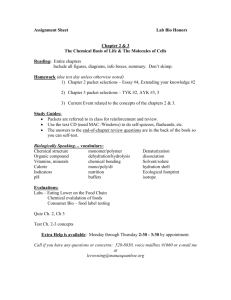Document 13308823
advertisement
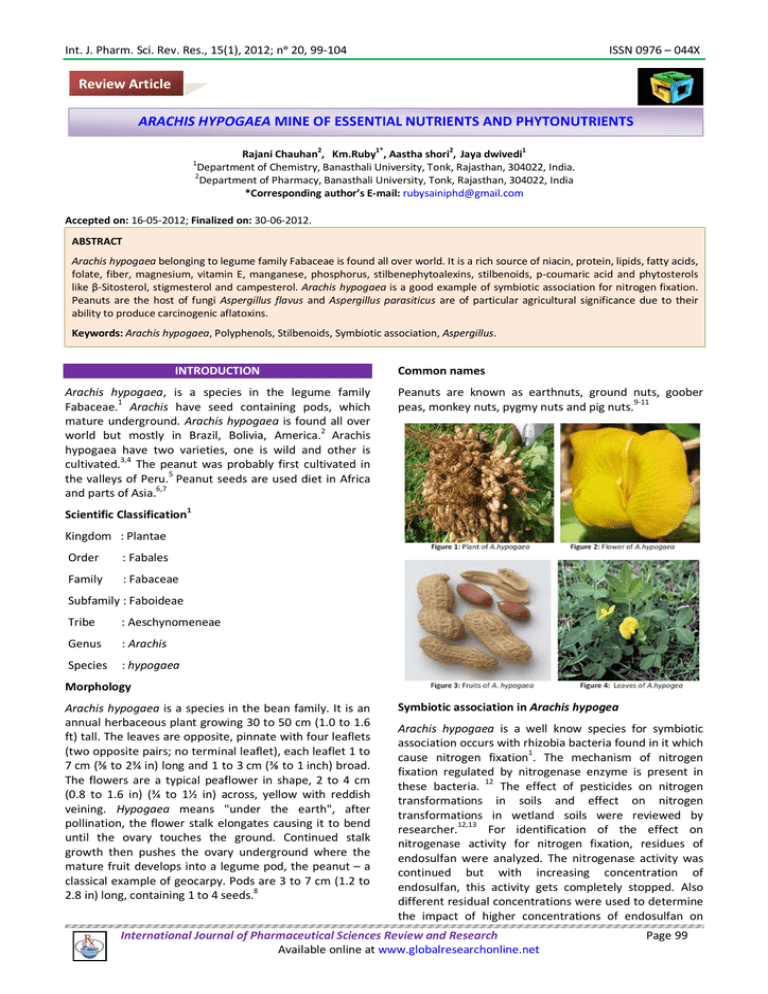
Int. J. Pharm. Sci. Rev. Res., 15(1), 2012; nᵒ 20, 99-104 ISSN 0976 – 044X Review Article ARACHIS HYPOGAEA MINE OF ESSENTIAL NUTRIENTS AND PHYTONUTRIENTS 2 1* 2 1 Rajani Chauhan , Km.Ruby , Aastha shori , Jaya dwivedi Department of Chemistry, Banasthali University, Tonk, Rajasthan, 304022, India. 2 Department of Pharmacy, Banasthali University, Tonk, Rajasthan, 304022, India *Corresponding author’s E-mail: rubysainiphd@gmail.com 1 Accepted on: 16-05-2012; Finalized on: 30-06-2012. ABSTRACT Arachis hypogaea belonging to legume family Fabaceae is found all over world. It is a rich source of niacin, protein, lipids, fatty acids, folate, fiber, magnesium, vitamin E, manganese, phosphorus, stilbenephytoalexins, stilbenoids, p-coumaric acid and phytosterols like β-Sitosterol, stigmesterol and campesterol. Arachis hypogaea is a good example of symbiotic association for nitrogen fixation. Peanuts are the host of fungi Aspergillus flavus and Aspergillus parasiticus are of particular agricultural significance due to their ability to produce carcinogenic aflatoxins. Keywords: Arachis hypogaea, Polyphenols, Stilbenoids, Symbiotic association, Aspergillus. INTRODUCTION Arachis hypogaea, is a species in the legume family Fabaceae.1 Arachis have seed containing pods, which mature underground. Arachis hypogaea is found all over world but mostly in Brazil, Bolivia, America.2 Arachis hypogaea have two varieties, one is wild and other is cultivated.3,4 The peanut was probably first cultivated in the valleys of Peru.5 Peanut seeds are used diet in Africa and parts of Asia.6,7 Common names Peanuts are known as earthnuts, ground nuts, goober peas, monkey nuts, pygmy nuts and pig nuts.9-11 Scientific Classification1 Kingdom : Plantae Order : Fabales Family : Fabaceae Subfamily : Faboideae Tribe : Aeschynomeneae Genus : Arachis Species : hypogaea Morphology Arachis hypogaea is a species in the bean family. It is an annual herbaceous plant growing 30 to 50 cm (1.0 to 1.6 ft) tall. The leaves are opposite, pinnate with four leaflets (two opposite pairs; no terminal leaflet), each leaflet 1 to 7 cm (⅜ to 2¾ in) long and 1 to 3 cm (⅜ to 1 inch) broad. The flowers are a typical peaflower in shape, 2 to 4 cm (0.8 to 1.6 in) (¾ to 1½ in) across, yellow with reddish veining. Hypogaea means "under the earth", after pollination, the flower stalk elongates causing it to bend until the ovary touches the ground. Continued stalk growth then pushes the ovary underground where the mature fruit develops into a legume pod, the peanut – a classical example of geocarpy. Pods are 3 to 7 cm (1.2 to 2.8 in) long, containing 1 to 4 seeds.8 Symbiotic association in Arachis hypogea Arachis hypogaea is a well know species for symbiotic association occurs with rhizobia bacteria found in it which 1 cause nitrogen fixation . The mechanism of nitrogen fixation regulated by nitrogenase enzyme is present in these bacteria. 12 The effect of pesticides on nitrogen transformations in soils and effect on nitrogen transformations in wetland soils were reviewed by researcher.12,13 For identification of the effect on nitrogenase activity for nitrogen fixation, residues of endosulfan were analyzed. The nitrogenase activity was continued but with increasing concentration of endosulfan, this activity gets completely stopped. Also different residual concentrations were used to determine the impact of higher concentrations of endosulfan on International Journal of Pharmaceutical Sciences Review and Research Available online at www.globalresearchonline.net Page 99 Int. J. Pharm. Sci. Rev. Res., 15(1), 2012; nᵒ 20, 99-104 ISSN 0976 – 044X Arachis hypogea. It is observed that the inhibitory effect was observed at (250 ppm) a very low concentration.12,13 Peanuts are host of fungi Aspergillus flavus and Aspergillus parasiticus are of particular agricultural significance due to their ability to produce carcinogenic aflatoxins20,21. The peanut plant can resist fungal attacks by promptly producing stilbene-derived phytoalexins.13-18 Chemical constituents and Pharmacological activities of Arachis hypogaea Peanuts are rich in nutrients, providing over 30 essential nutrients and phytonutrients. Peanuts are a good source of niacin19, protein, lipids, and fatty acids.6 folate, fiber, 20 magnesium, vitamin E, manganese and phosphorus 18,21-25 25-27, 58-64 stilbenephytoalexins stilbenoids, pcoumaric acid. 28 They are also naturally free of trans-fats 20 and sodium, and contain about 25% protein. Peanuts are a significant source of resveratrol, a chemical associated with but not proven to cause a reduction in risk of cardiovascular disease and cancer.29 The average amount of resveratrol in one ounce of commonly eaten peanuts is 73 µg.30 Peanuts are a source of coenzyme Q10, as are oily fish, beef, soybeans and spinach.31 They are a potential source of many micronutrients and bioactive constituents. Which are responsible for nutritional and physicochemical properties 32,33 Phytosterols are generally dominated by the chemically defined group 4-desmethylsterols, which have the same structural base as cholesterol but with one or two extra carbon atoms in the side chain. Whereas about 250 types of phytosterols are actually reported in the literature, nutrition research has focused mostly upon the unsaturated β-sitosterol, campesterol, and stigmasterol. Phytostanols, a fully saturated subgroup of phytosterols, are less abundant in nature than phytosterols and are not found in peanut kernels.35-37 O OH H H HO H HO p-Coumaric acid Campesterol The results of the phytochemical screening carried out on the seeds of Arachis hypogea (Groundnut) showed the presence of useful phytonutrients. The results showed that A. hypogea showed the lowest yield of alkaloid (0.25%), saponin content (0.25%), flavonoids (0.18%) and tannins.43 Phenylpropanoid derivatives mainly stilbenes and flavonoids are found in this genus. These compounds are involved in a defense mechanism against physical injuries and microbial contamination. Indeed, the correlation between the concentration of several compounds and their effects on injuries or contamination has been fully reported.65-74 The stilbenes that have been reported for several varieties from A. hypogaea in different organs from the plant, such as leaves, roots, and seeds, seem to be derived from trans-resveratrol, such as piceid,37-39 isopentadienylresveratrol (IPD)16 piceatannol, arachidin-1 arachidin-2, arachidin-3,41-43 and trans-SB-1.44 OH OH HO O HO OH HO Piceid OH OH OH OH H3C CH3 OH H3C H3C H3C O Piceatannol CH3 H3C CH3 Vitamine E HO H O H OH HO H H OH OH Stibenephytoalexins H H CH3 H HO H3C CH3 CH3 H CH3 H CH3 H H H HO H H β-Sitsterol CH3 H3C H H CH3 H H CH3 H3C H3C Stigmesterol Four new stilbene derivatives, termed arahypins, have been isolated from peanut seeds challenged by an Aspergillus caelatus strain, along with two known stilbenoids that have not been previously reported in peanuts. The structures of these new putative phytoalexins were determined by analysis of NMR, MS, and UV data. Together with other known peanut stilbenoids that were also produced in the challenged seeds, these new compounds may play a defensive role against invasive fungi.45 Arachis hypogaea L. leaf aqueous extracts have received a long reputation in china as an abirritative remedy to ease various sleep disorders 46,47 and clinically validated by modernistic medical approaches48,49. However, many those researches only focus on the clinical effects, and relevant studies on their deep effect mechanisms are still lacking. International Journal of Pharmaceutical Sciences Review and Research Available online at www.globalresearchonline.net Page 100 Int. J. Pharm. Sci. Rev. Res., 15(1), 2012; nᵒ 20, 99-104 4-Desmethylsterols, the main component of the phytosterol fraction, have been analyzed during the development of Tunisian peanut kernels (Arachis hypogaea L.), Trabelsia (AraT) and Chounfakhi (AraC), which are monocultivar species, and Arbi (AraA), which is a wild species, by gas chromatography-mass spectrometry. Immature wild peanut (AraA) showed the highest contents of β-sitosterol (554.8 mg/100 g of oil), campesterol (228.6 mg/100 g of oil), and 5-avenasterol (39.0 mg/100 g of oil) followed by peanut cultivar AraC with β-sitosterol, campesterol, and 5-avenasterol averages of 267.7, 92.1, and 28.6 mg/ 100 g of oil, respectively, and similarly for AraT 309.1, 108.4, and 27.4 mg/100 g of oil, respectively, were found. These results suggest that, in immature stages, phytosterol contents can be important regulator factors for the functional quality of peanut oil for the agro-industry chain from 45 plant to nutraceuticals. H HO H H HO 4-desmethylsterols Campesterol H3C CH3 H3C CH3 CH3 CH3 HO 5-Avenansterol The biochemical composition and some phytochemicals in the seeds of 4 groundnut (Arachis hypogaea L.) varieties viz., Golden, Barri 2000, Mongphalla and Mongphalli 334 cultivated in arid zones of Pakistan, were determined. The biochemical analysis included ash, crude fat, total nitrogen, proteins and sugar contents. A statistically significant difference (p<0.05) was observed among the varieties regarding the ash, crude fat, water soluble proteins, salt soluble proteins and sugar contents. The four groundnut varieties were also found to be significantly different (p<0.05) on the basis of phytochemicals analysed including tannins (822±3.78 to 903±4.45 mg/100g), saponins (438±2.12 to 480±2.30 mg/100g), non-protein nitrogen (1.33±0.03 to 1.56±0.02 mg/100g), hydrogen cyanide (40.80±0.32 to 42.82±0.75 mg/100g), total phenolic acids (218±2.11 to 256±2.02 mg/100g), total phosphorus (700±3.62 to 889±3.84 mg/100g) and phytic acid (572±4.37 to 714±3.74 mg/100g). The results obtained from the present studies could be a source of valuable information and a guideline for the food scientists, researchers and even the nut consumers not only in Pakistan but all over the world.50 ISSN 0976 – 044X Eight medicinal plants were tested for their antimicrobial and antioxidant activities. Different extraction methods were also tested for their effects on the bioactivities of the medicinal plants. The plant were Herba Polygonis Hydropiperis (Laliaocao), Folium Murraya Koenigii (Jialiye), Rhizoma Arachis Hypogea (Huashenggen), Herba Houttuyniae (Yuxingcao), Epipremnum pinnatum (Pashulong), Rhizoma Typhonium Flagelliforme (Laoshuyu), Cortex Magnoliae Officinalis (Houpo) and Rhizoma Imperatae (Baimaogen) Extracts of Cortex Magnoliae Officinalis had the strongest activities against M. Smegmatis, C. albicans, B. subtilis and S. aureus. Arachis hypogaea demonstrated moderate antioxidant activity than other tested medicinal plants.51 Arachis hypogaea was screened for potential antibacterial activity against Staphylococcus aureus, Staphylococcus epidermidis, and Staphylococcus subflava. Antibacterial activity of aqueous and alcoholic extracts of Arachs hypogaea was performed by agar disc diffusion method and agar well diffusion method. The alcoholic extracts were more active than aqueous extracts. The most susceptible bacterium was S. aureus. The in vitro susceptibility testing of the studied Staphylococcus strains was done against standard antibiotics.52 A new pigmented, optically active, low molecular weight metabolite has been isolated from Arachis hypogaea challenged by four species of Aspergillus. The structure of the new compound, termed SB-1, was elucidated by analysis of 1H NMR, 13C NMR, and mass spectrometric data. The SB-1 molecule bears prenylated benzenoid and but-2-enolide moieties and represents an unusual class of compounds. The closest known analogue to SB-1 was isolated from heartwood of Pericopsis elata. Both A. hypogaea and P. elata belong to the family Leguminosae. The new metabolite was accumulated in different peanut genotypes challenged by five Aspergillus species and may be an important representative of a new class of peanut phytoalexins. SB-1 production often exceeds production of major known stilbenes.53 Peanut is a potent plant to be induced to synthesize bioactive stilbenoids. These stilbenoids and butylatedhydroxytoluene (BHT) were subjected to antioxidant characterization by various measures, all have exhibited varied potencies of antioxidant activity. In particular, retardation of absorbance increase at 234 nm as formation of the conjugated diene hydroperoxides in a real pork oil system, supplement of Ara-1 at 100 íM has shown equivalent or even greater activity than did BHT. When the media were supplemented with Res, Ara-1, Ara-3, and IPD at 15 íM for cultivation of mouse macrophage RAW 264.7 cells activated by lipopolysaccharide (LPS), the LPS-induced extracellular production of prostaglandin E2 (PGE2) and nitric oxide (NO) was significantly inhibited by Ara-1 (p < 0.001), Res (p < 0.001), Ara-3 (p < 0.01), and IPD (p < 0.01). It is noteworthy and of merit that all test stilbenoids have exhibited potent antioxidant and anti-inflammatory International Journal of Pharmaceutical Sciences Review and Research Available online at www.globalresearchonline.net Page 101 Int. J. Pharm. Sci. Rev. Res., 15(1), 2012; nᵒ 20, 99-104 activities and varied as affected by number of hydroxyl groups and isopentenyl or isopentadienyl moiety.54 CH3 H 3C CH3 OH CH3 H 3C CH3 CH3 Butylatedhydroxytoluene Both resveratrol and piceatannol are recognized as important ingredients in functional foods due to their beneficial health effects. However, unlike resveratrol, the piceatannol concentration in plants is very low. Thus, calluses of peanuts, an easily obtainable source, were chosen as the material to induce piceatannol production under controlled conditions. To induce resveratrol and piceatannol, calluses were exposed to the ultraviolet (UV) irradiation. Significant quantities of resveratrol and piceatannol were produced by calluses upon UV irradiation in both static and suspension culture conditions. In suspension culture, the amounts of induced piceatannol and resveratrol were somewhat lower. The quantities of induced piceatannol and resveratrol reached a maximum at 18 h after UV irradiation treatment in static culture. In contrast, the levels of resveratrol and piceatannol remained almost constant throughout the experiments in suspension culture. The piceatannol produced by calluses in all studies was much higher than the values reported in the literature, whereas the resveratrol produced was comparable to reported values.55 OH HO ISSN 0976 – 044X determined by sedimentation and diffusion and by gel filtration, was found to be 110,000. Disc gel electrophoresis and gel filtration, both in the presence of sodium dodecylsulfate, gave a single component of M, = 27,500 suggesting that the lectin is a tetramer composed of four subunits. Four alanine residues per 110,000 g were found by NH,-terminal analysis and the sequence of the five NH,-terminal amino acids was: Ala-Glu-Ser-ValThr. Each cycle in a sequenator gave a single amino acid, suggesting that the four subunits are identical. Peanut agglutinin does not contain covalently bound sugar; it is devoid of cysteine and cystine, low in methionine, histidine, and tryptophan, but rich in acidic and hydroxyamino acids. Desialylated glycoproteins also reacted with the lectin to form precipitin bands in ouchterlony double diffusion in agar. Extracts of peanut (Arachis hypogaea) have been known for some time to agglutinate neuraminidase-treated human red blood cells. The agglutinin was designated “anti-T agglutinin” since it gave the same immunological reaction as the antiT antibody of mammalian sera which is responsible for Tpolyagglutination occurring in several bacterial and viral infections. In fact peanut extracts have been used for clinical determination of T-polyagglutinability, but no attempt has been made to obtain the lectin in pure, homogeneous form. Since the agglutinating activity of peanut extracts could be inhibited by galactose and by lactose, we tried to purify the lectin by affinity chromatography on a column of sepharose-caminocaproyl-p-galactopyranos-lamine previously prepared by us for the isolation of soybean agglutinin. Peanut agglutinin thus purified was obtained in a homogeneous form. In this paper we describe the procedure for the purification of peanut agglutinin as well as some of the physicochemical and biological properties of the purified lectin.57 O S OH Resveratrol Immunochemical activity of the Arachis hypgaea lectin has been equated, in spite of its different hapten combining requirements, with that of the human anti- T (Thomsen-Friedenreich) antibody population which is of importance in cancer immunology. The NN and MM antigens had about 50% of maximal activity toward the Arachis lectin. The slower appearance of T antigen upon graded desialation of MM antigen is likely due to the higher concentration of NeuAc and difference in some of its linkages on intact MM as compared to NN antigen.56 Peanut agglutinin was purified by affinity chromatography on Sepharose-c-aminocaproyl-B-D galactopyranosyl amine. The purified lectin obtained in a yield of 150 mg/lOO g of defatted peanut was homogeneous on polyacrylamide gel electrophoresis, ultracentrifugation. and gel filtration. The intrinsic sedimentation coefficient and the intrinsic diffusion coefficient were estimated at pH 7.4. The molecular weight of the agglutinin, H3C OH NH2 Cysteine Methionine OH H O H NH2 C O H HO S C N H CH2 H S N H H C C O H2 N N C H OH Cystine Histidine OH O HO OH OH HN NH2 Tryptophan International Journal of Pharmaceutical Sciences Review and Research Available online at www.globalresearchonline.net OH Piceatannol Page 102 Int. J. Pharm. Sci. Rev. Res., 15(1), 2012; nᵒ 20, 99-104 REFERENCES 1. H.M. Shivaramaiah. Preferential utilization of endosulfan isomers and degradation by two fungal consortia. Pesticide Research Journal, 21(1), 2009, 105-108. 2. Grosso NR, Zygadlo AJ, Lamarque AL, Maestri DM, Guzman CA. Proximate, fatty acid and sterol compositions of aboriginal peanut (Arachis hypogaea L) seeds from Bolivia. J. Sci. Food Agric. 73:1997; 349–356. 3. Krapovickas A, Gregory WC. Taxonomia del genero Arachis (Leguminosae). Bonplondia 8:1994; 1–186. 4. Grosso NR, Nepote V, Guzman CA. Chemical composition of some wild peanut species (Arachis L.) seeds. J. Agric. Food Chem. 48:2000; 806–809. 5. World Geography of the Peanut. University of Georgia. 2004-0102. 6. Cherry JP. Potential sources of peanut seed proteins and oil in the genus Arachis. J. Agric. Food Chem. 25:1977; 186–193. 7. Aicha O, Cherif Hajer, Trabelsi, Mhamed, Messaouda B. Gas Chromatography-Mass Spectrometry Screening for Phytochemical 4-Desmethylsterols Accumulated during Development of Tunisian Peanut Kernels (Arachis hypogaea L.) J. Agric. Food Chem. 58:2010; 8709–8714 8. Michael CY, The peanut Alergy Answer Book, Fair Winds publishing, 2006, ISBN 1-59233-233-1. 9. 9."Webster’sdictionary".http://www.eurekalert.org/pub_releases/ 2007-06/vueeo062507 php. 10. "Dictionary.die.net". http://dictionary.die.net/earthnut. 11. "Bird feeding on About.com". http://birding.about.com/od/birdfeeders/a/peanuts.htm. 12. Darure MV, Chonde SG, Bhosale PR. Raut PD. Effect of residual concentration of Endosulfan on the nitrogenase enzyme activity in Arachis hypogea. Annals of Biological Research. 3(1):2012; 192-195 13. Sobolev VS, Khan SI, Tabanca N, Wedge DE, Manly SP, Cutler SJ, Coy MR, Becnel JJ, Neff SA, Gloer JB. Biological activity of peanut (Arachis hypogaea) Phytoalexins and selected natural and synthetic Stilbenoids. J Agric Food Chem. 59(5):2011: 1673-1682. 14. Sharma RP, Salunkhe DK, Paxton JD. Biosynthesis and accumulation of legume phytoalexins in Mycotoxins and Phytoalexins; Eds.; CRC Press: Boca Raton, FL, 1991; 485-499. ISSN 0976 – 044X 24. Sobolev VS, Potter TL, Horn BW. Prenylated stilbenes from peanut root mucilage. Phytochem. Anal. 17:2006; 312–322. 25. Sobolev VS, Deyrup ST, Gloer JB. New peanut (Arachis hypogaea) phytoalexin with prenylated benzenoid and but-2- enolide moieties. J. Agric. Food. Chem. 54, 2006, 2111–2115. 26. Yoder BJ, Cao S, Norris A, Miller JS, Ratovoson F, Razafitsalama J, Andriantsiferana R, Rasamison VE, Kingston DGI. Antiproliferative prenylated stilbenes and flavonoids from Macaranga alnifolia from the Madagascar rainforest. J. Nat. Prod. 70:2007; 342–346. 27. Huang KS, Wang YH, Li RL, Lin M. Stilbene dimmers from the lianas of Gnetum hainanense. Phytochemistry 54:2000; 875–881. 28. "Peanuts: World's Healthiest Foods". Whfoods.com. http://www. whfoods. com/ gen page.php?tname=foodspice&dbid=101. 29. Sanders TH, McMichael RW, HendrixKW. Occurrence of resveratrol in edible peanuts". Journal of Agricultural and Food Chemistry. 48 (4): 2000; 1243–1246. 30. Sanders, Timothy H.; Robert, W. McMichael Jr.; Hendrix, Keith W. Occurrence of resveratrol in edible peanuts. J Agric Food Chem. 48: 2000; 1243–1246. 31. "Coenzyme Q10". American Cancer Society. 2007-07-20. www. cancer.org/docroot/ETO/content/ETO_5_3X_Coenzyme _Q10.asp? sitearea=ETO. 32. Sivakumar G, Briccoli-Bati C, Perri E, Uccella N. Gas chromatography screening of bioactive phytosterols from monocultivar olive oils. Food Chem. 95:2006; 525–528. 33. Bradford, P. G.; Awad, A. B. Phytosterols as anticancer compounds. Mol. Nutr. Food Res. 51,2007, 161–170. 34. Ramadan FA, Zayed R, El-Shamy H. Screening of bioactive lipids and radical scavenging potential of some solanaceae plants. Food Chem. 103:2007; 885–890. 35. Baiyi, L.; Ying, Z.; Xiaoqin, W.; Jiayi, S. Separation and determination of diversiform phytosterols in food materials using supercritical carbon dioxide extraction and ultraperformance liquid chromatography- atmospheric pressure chemical ionization-mass spectrometry. Anal. Chim. Acta 588,2007, 50–63. 36. Mbagwu FN, Okafor VU, Ekeanyanwu J. Phytochemical screening on four edible legumes (Vigna subterranean, Glycine max, Arachis hypogea, and Vigna uniguiculata) found in eastern Nigeria. African Journal of Plant Science. 5(6):2011; 370-372. 15. Rao S, Strange PV, Chemistry, biology, and role of groundnut phytoalexins in resistance to fungal attack. In Handbook of Phytoalexin Metabolism and Action; Daniel, M.; Purkayastha, R. P., Eds.; Dekker: New York, 1995;199-227. 37. Tokusoglu O, Unal MK, Yemis F. Determination of the phytoalexin resveratrol (3,5,40-trihydroxystilbene) in peanuts and pistachios by high-performance liquid chromatographic diode array (HPLC-DAD) and gas chromatography_mass spectrometry (GCMS). J. Agric. Food Chem. 53:2005; 5003–5009. 16. Sharma RP, Salunkhe DK, Cole RJ, Dorner JW. Peanut phytoalexins. In Mycotoxins and Phytoalexins; Eds.; CRC Press: Boca Raton, FL, 1991; 501-509. 38. Sanders TH, McMichael RW, Hendrix KW. Occurrence of resveratrol in edible peanuts. J. Agric. Food Chem. 48: 2000; 1243– 1246. 17. Dorner JW, Cole RJ, Sanders TH, Blankenship PD. Interrelationship of kernel water activity, soil temperature, maturity, and phytoalexin production in preharvest aflatoxin contamination of drought-stressed peanuts. Mycopathologia 105: 1989; 117–128. 39. Chen RS, Wu PL, Chiou RYY. Peanut roots as a source of resveratrol. J. Agric. Food Chem. 50:2002; 1665–1667. 18. Sobolev VS, Guo BZ, Holbrook CC, Lynch RE. Interrelationship of phytoalexin production and disease resistance in selected peanut genotypes. J. Agric. Food. Chem. 55: 2007; 2195–2200. 19. "Peanuts at the World's Healthiest Food". http://www. whfoods.com/ genpage.php? tname=foodspice&dbid=101. 40. Cooksey CJ, Garratt PJ, Richards SE, Strange RN. A dienyl stilbene phytoalexin from Arachis hypogaea. Phytochemistry 27:1988; 1015–1016. 41. Sobolev VS, Cole RJ, Dorner JW, Yagen B. Isolation, purification, and liquid chromatographic determination of stilbene phytoalexins in peanuts. J. AOAC Int. 78:1995; 1177–1182. 20. "Nuts – Heathly, Tasty & High in Protein". Weightlossforall.com. http://www. weight lossforall.com/protein-nuts.htm. 42. Ku KL, Chang PS, Cheng YC, Lien CY. Production of stilbenoids from the callus of Arachis hypogaea: a novel source of the anticancer compound piceatannol. J. Agric. Food Chem. 53:2005; 3877–3881. 21. Keen NT, Ingham JL. New stilbene phytoalexins from American cultivars of Arachis hypogaea. Phytochemistry 15, 1976, 1794– 1795. 43. Sobolev VS. Localized production of phytoalexins by peanut (Arachis hypogaea) kernels in response to invasion by Aspergillus species. J. Agric. Food Chem. 56:2008: 1949–1954. 22. Aguamah GA, Langcake P, Leworthy DP, Page JA, Pryce RJ, Strange RN. Two novel stilbene phytoalexins from Arachis hypogaea. Phytochemistry 20: 1981; 1381–1383. 44. Lopes RM, Gostini-Costa TDS, Gimenes MA,S Silveira DA. Chemical Composition and Biological Activities of Arachis Species J. Agric. Food Chem. 59:2011; 4321–4330. 23. Cooksey CJ, Garratt PJ, Richards SE, Strange RN. A dienyl stilbene phytoalexin from Arachis hypogaea. Phytochemistry 27:1988: 1015–1016. 45. Sobolev VS, NEFF SA, Gloer JB, New Stilbenoids from Peanut (Arachis hypogaea) Seeds Challenged by an Aspergillus caelatus Strain J. Agric. Food Chem. 57,2009, 62–68. International Journal of Pharmaceutical Sciences Review and Research Available online at www.globalresearchonline.net Page 103 Int. J. Pharm. Sci. Rev. Res., 15(1), 2012; nᵒ 20, 99-104 46. Zu XY, Zhang ZY, LiuJQ, Hu HH, Xing GQ, Zhang Y, Guan D. Sedative effects of peanut (Arachis hypogaea L.) leaf aqueous extracts on brain ATP, AMP, Adenosine and Glutamate/GABA of rats J. Biomedical Science and Engineering. 3:2010; 268-273 47. Wang QC, Xu J, Shi M. Clinical efficacy of Groundnut leaves on insomnia treatments. Shanghai Journal of Traditional Chinese Medicine. 5:2001; 8-10. ISSN 0976 – 044X 59. Morita H, Noguchi H, Schroder J, Abe I. Novel polyketides synthesized with a higher plant stilbene synthase. Eur. J. Biochem. 268:2001; 3759–3766. 60. Dixon RA, Pavia NL. Stress-induced phenylpropanoid metabolism. Plant Cell. 7:1995; 1085–1097. 61. Hart JH. Role of phytostilbenes in decay and disease resistance. Annu. ReV. Phytopathol. 19:1981; 437–458. 48. Hu PF, Fan RP, Li YP, Pang CY. Studies on pharmacological action of Luohuashe ngzhiye extracts. Chinese Traditional Patent Medicine. 23: 2001; 919- 920. 62. Ioset JR, Marston A, Gupta MP, Hostettman K. Five new prenylated stilbenes from the root bark of Lonchocarpus chiricanus. J. Nat. Prod. 64:2001; 710–715. 49. Wang, YF, Li HF, Xu YF, Zhang YL, Xu DS, Xiao LM , Li XM. Clinical confirmation of preparation from the branch and leaf of peanut in treating insomnia. Shanghai Journal of Traditional Chinese Medicine. 35:2001; 8-10 63. Su BN, Cuendet M, Hawthorne ME, Kardano LBS, Riswan S, Fong HHS, Mehta RG, Pezzuto JM, Kinghorn AD. Constituents of the bark and twigs of Artocarpus dadah with cyclooxygenase inhibitory activity. J. Nat. Prod. 65: 2002; 163–169. 50. Muhammad AS, Humayun P, Nawaz, Khan H, Ullah MA. Evaluation of biochemical and phytochemical composition of some groundnut varieties grown in arid zone of Pakistan. Pak. J. Bot. 41(6):2009; 2739-2749. 64. Langcake P, Pryce RJ. A new class of phytoalexins from grapevines. Experientia 33:1977; 151–152. 51. Lai WC, Emily LCC, Constance LLS, Wanyu W, Paul WSH.Antimicrobial and antioxidant activities of Cortex Magnoliae Officinalis and some other medicinal plants commonly used in South-East Asia Chinese Medicine. 3:2008; 15 52. Parekh J. Chanda SV. Antibacterial Activity of Aqueous and Alcoholic Extracts of 34 Indian Medicinal Plants against Some Staphylococcus Species.Turk J Biol. 32:2008; 63-71 53. Sobolev VS, Deyrup ST, Glover JB. New Peanut (Arachis hypogaea) Phytoalexin with Prenylated Benzenoid and But-2-enolide Moieties. J. Agric. Food Chem. 54: 2006; 2111-2115. 54. Doktorska P, Biosynthesis Enhancement and Antioxidant and Antiinflammatory Activities of Peanut (Arachis hypogaea L.) Arachidin1, Arachidin-3, and Isopentadienyl resveratrol J. Agric. Food Chem. 54:2006; 10281-10287. 65. Pendse R, Rao AV, Venkataraman K. 5,7-Dihydroxychromone from Arachis hypogaea shells. Phytochemistry. 12:1973; 2033–2034. 66. Lee JH, Baek IY, Ha TJ, Choung MG, Ko JM, Oh SK, Kim HT, Ryu HW, Park KY, Park KH. Identification and characterization of phytochemicals from peanut (Arachis hypogaea L) pods. Food Sci. Biotechnol. 17:2008; 475–482. 67. Devi CM, Reddy MN. Phenolic acid metabolism of groundnut (Arachis hypogaea L.) plants inoculated with VAM fungus and Rhizobium. Plant Growth Regul. 37:2002; 151–156. 68. Sobolev VS, Horn BW, Potter TL, Deyrup ST, Gloer JB. Production of stilbenoids and phenolic acids by the peanut plant at early stages of growth. J. Agric. Food Chem. 54:2006; 3505–3511. 69. Sobolev VS, Neff SA, Gloer JB. New dimeric stilbenoids from fungalchallenged peanut (Arachis hypogaea) seeds. J. Agric. Food Chem. 58:2010; 875–881. 55. Ku KL, Cheng PS, Lien CY. Production of Stilbenoids from the Callus of Arachis hypogaea: a Novel Source of the Anticancer Compound Piceatannol .J. Agric. Food Chem. 53(10):2005; 3877-3881. 70. Sobolev VS, Neff SA, Gloer JB. New stilbenoids from peanut (Arachis hypogaea) seeds challenged by an Aspergillus caelatus strain. J. Agric. Food Chem. 57:2009; 62–68. 56. Georg FL. Springer S, Parimal RD. Extent of Desialation of Blood Group MM, NN, and MN Antigens Required for Reactivity with Human Anti-T Antibody and Arachis hypogaea.The journal of biological chemistry. 257(6):1982; 274-2746. 71. Sobolev VS, Guo BZ, Holbrook CC, Lynch RE. Interrelationship of phytoalexin production and disease resistance in selected peanut genotypes. J. Agric. Food Chem. 55:2007; 2195–2200. 57. Lotan R, Skutelsky E, Danon, Sharon N, The Purification, Composition, and Specificity of the Anti-T Lectin from Peanut (Arachis hypogaea).The journal of biological chemistry. 250(21): 1975; 8514-8523. 58. Hahlbrook K, Scheel D. Physiology and molecular biology of phenylpropanoid metabolism. Annu. ReV. Plant Physiol. Plant Mol. Biol. 40:1989; 347–369. 72. Sobolev VS, Deyrup ST, Gloer JB. New peanut (Arachis hypogaea) phytoalexin with prenylated benzenoid and but-2-enolide moieties. J. Agric. Food Chem. 54:2006; 2111–2115. 73. Sobolev VS, Cole RJ, Dorner JW, Yagen B. Isolation, purification, and liquid chromatographic determination of stilbene phytoalexins in peanuts. J. AOAC Int. 78: 1995; 1177–1182. 74. Sobolev VS, Cole RJ. trans-Resveratrol content in commercial peanuts and peanut products. J. Agric. Food Chem. 47:1999; 1435– 1439. ********************* International Journal of Pharmaceutical Sciences Review and Research Available online at www.globalresearchonline.net Page 104
